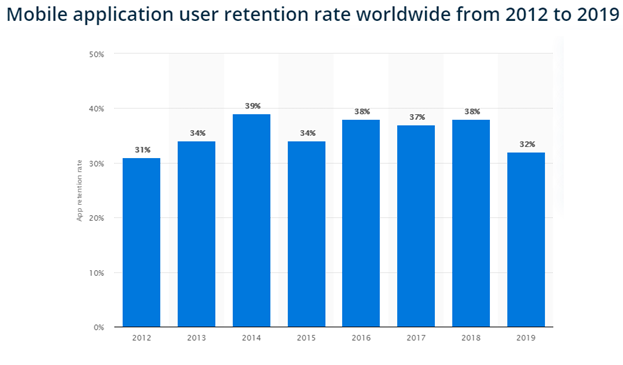Mobile phones have become synonymous in today’s times and there is a high probability that the mobile phone will be the first point of engagement with your website (or web app). Mobile penetration is taking the entire world by storm (including emerging economies).
As per Statista[1], the number of mobile devices worldwide is expected to reach 17.72 billion by 2024 (an increase of 3.7 billion in comparison to 2020). Enterprises (and individual app developers) are coming up with mobile apps to provide relevant solutions to the mobile-first audience. However, there is a growing issue in the user retention rate which stood at 32 percent (at the end of 2019)[2].

These numbers indicate that developing a winning app and getting it downloaded is half the job done, as a lot of effort has to be put in retention and engagement. In order to deliver a top-class in-app experience, every element and feature of the app has to be thoroughly tested. This in turn has a positive impact on the key metrics of the mobile app. Thus, mobile app testing is extremely crucial since it can make or break the offerings of the app.
What is Mobile App Testing?
Mobile app testing is the process of testing the mobile application from different perspectives like performance, compatibility, usability, and other characteristics that are important for boosting the mobile app metrics. The growing fragmentation of screen sizes, resolutions, hardware capabilities, etc. add unnecessary complications to process of mobile app testing.
Be sure to check out the mobile app testing checklist for releasing a quality app on the respective mobile app store. This helps in increasing download rates, improving app reviews, and increasing the user retention rate.
It is recommended to partner with a company with expertise in providing mobile app testing services in case you want to accelerate the process of mobile app testing.
Types of Mobile Apps
The strategy for testing mobile applications largely depends on the type of mobile application. Here are the three major categories of mobile apps:
1. Web Apps
Web applications are mobile apps that are accessed using the mobile web browser. Apps in this category are not downloadable since the normal website is presented to suit the mobile device (and resolution) requirements.
Web apps have to be tested for performance and cross-browser compatibility since your users can use their choice of web browsers (and devices) to access the web application.
2. Native Apps
Native apps are mobile applications that are developed specifically for the corresponding smartphone operating system. These are installed through the application store (i.e. Google Play Store or Apple’s iOS Store).
Since native apps are developed for the platform, the apps leverage the device capabilities such as GPS, camera, accelerometer, gyrometer, and more. Platform (or OS) specific APIs are used for the development of native applications.
Also Read: 10 Effective Mobile App Testing Types
3. Progressive Web Apps
Though Progressive Web Apps (PWAs) are types of web applications, they can be considered as a separate category considering the growing number of enterprises opting for PWAs.
Progressive Web Apps are web apps that make use of emerging web browser APIs and progressive enhancement strategies for delivering an app with a near native-like user experience with improved installability and reliability.
4. Hybrid Apps
Hybrid apps have look & feel like native apps. These apps are developed using multi-platform web technologies like HTML5, CSS, and JavaScript. The developed code is embedded into native wrapper frameworks such as PhoneGap, Xamarin, etc.
Akin to native apps, hybrid apps can also access the device hardware (or native functions) like camera, GPS, Bluetooth, microphone, etc.
Also Read: 7 Best Practices for Mobile App Testing
What can you test in mobile app testing?
Here are the major things that can be tested as a part of the mobile app testing strategy:
1. User Flow
User flow in a mobile application indicates the series (or sequence) of actions that a user performs to complete any operation. In the case of an e-commerce app, a typical user flow would be like this:
User signing-in the application > Browse required products > Add necessary products to the cart > Checkout & payment
Every mobile application has its own user flow and the flow depends on the category of the business case (e.g. e-commerce, online insurance, online bill payments, etc.)
2. Push Notifications
Sending push notifications tailor-made to the customer preferences is one of the mechanisms used by online businesses to retain customers and drive engagement. However, the app development and test teams have to test the push notifications for figuring out the best time to get a response.
Though the focus should be on improving the CTR (Click Through Rate), it should not cause annoyance to the users of the app. As a part of mobile app testing, importance should be put on personalizing the app notifications and doing A/B testing with a mix of text (and/or images, emojis, etc.).
Also Read: Reasons Why You Should Outsource Mobile App Testing
3. In-App Experiences
As a part of the mobile app testing process, you should check out the overall layout and logical flow of the application. A good layout and pleasing design result in improved functionality and a seamless user experience.
The CTA (Call To Action) buttons, product descriptions, and other textual information should be placed at the relevant places in the app to enhance the in-app user experience. In a nutshell, in-app experience is one of the most critical factors to improve the stickiness factor of the app.
Over and above, mobile app testing should encompass testing of features like product recommendations, payment gateways, etc. Such features can only be tested on the server-side.
Conclusion
Mobile app testing should be taken on a priority basis, especially when you are building a product for the mobile-first audience. Since there are a plethora of tools available in the market, you should choose the best mobile testing support tools to give shape to your test strategy. In this first article of the mobile app testing series, we looked at the what, why, and how of mobile app testing.
In the subsequent articles of this series, we would touch upon how you can perform mobile app testing for Android and iOS apps. You should also take into account the factor of device fragmentation when devising the app testing strategy; else you might waste your valuable resources on testing on devices (that are not used by the users of the target market).
This is where KiwiQA, an expert mobile application testing company, can help in developing a fool-proof mobile app testing strategy.
